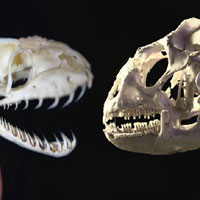Join us for conversations that inspire, recognize, and encourage innovation and best practices in the education profession.
Available on Apple Podcasts, Spotify, Google Podcasts, and more.

Which skull is a lizard and which is a snake?
During this session, you will have an opportunity to build understandings to help you:
What makes a snake a snake, and a lizard a lizard? What distinguishes one type of lizard from another? And how did so many types of reptiles come to be? Session 6 focuses on questions like these as we continue our study of the fundamentals of evolution. Building upon key ideas introduced last session–variation and adaptation through natural selection–we focus upon what defines a species and how new species evolve.
Deep within the basement of the Museum of Comparative Zoology at Harvard University, there is a treasure trove of life forms ready for study. The program opens inside the reptile and amphibian collection, where we begin to see part of what informs the work of evolutionary biologists.
Dr. Karen Worth, representing the Insights curriculum from the Educational Development Center (EDC), describes how the study of evolution can begin in the elementary grades. The fifth graders in Gail Modugno’s classroom in Springfield, Massachusetts give us a glimpse of what this might look like as her students begin to connect similarities among life forms to the possibility of relatedness. Our fourth and fifth graders in the Science Studio connect us to research on children’s ideas throughout the program as they ponder the meaning of species, adaptation, evolution, and relatedness.
Dr. Jim Hanken, from the Museum of Comparative Zoology, helps us dig deeper by using snake and lizard specimens to explore the meaning of “species.” Dr. Doug Causey, also from the museum, presents us with a collection of “Darwin’s finches” to propose a scenario for how new species might evolve through natural selection.
A tree of life is introduced as a model that portrays how scientists think life on Earth evolved, and a scenario for vertebrate evolution is described. Dr. Paul Williams returns to update us on the progress of Bottle Biology, highlighting the results of an experiment that explores the fundamentals of evolution.